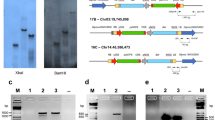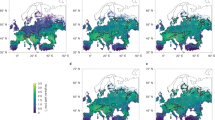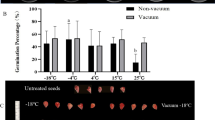Abstract
Pisum sativum has been put forward as a practical alternative to soybean (Glycine max) as a protein source that can be grown in temperate climates. In contrast to the cereals little attention has been paid to the contribution of the reproductive parts of Pisum sativum in the carbon economy of the developing seed. This information would be important in subsequent breeding programmes designed to exploit knowledge of the physiological components of yield.
This is a preview of subscription content, access via your institution
Access options
Subscribe to this journal
Receive 51 print issues and online access
$199.00 per year
only $3.90 per issue
Buy this article
- Purchase on SpringerLink
- Instant access to full article PDF
Prices may be subject to local taxes which are calculated during checkout
Similar content being viewed by others
References
Lovell, P. H., and Lovell, P. J., Physiol. Pl., 23, 316–322 (1970).
Flinn, A. M., Physiol. Pl., 31, 275–278 (1974).
Quebedeaux, B., and Chollet, R., Pl. Physiol., Lancaster, 55, 745–748 (1975).
Andrews, A. K., and Svec, L. V., Can. J. Pl. Sci., 55, 501–505 (1975).
Crookston, R. K., O'Toole, J., and Ozbun, J. L., Crop Sci., 14, 708–712 (1974).
Kunitake, G., Stitt, C., and Saltman, P., Pl. Physiol., Lancaster, 34, 123–127 (1959).
Hall, D. O., Huffaker, R. C., Shannon, L. M., and Wallace, A., Biochim. biophys. Acta, 35, 540–542 (1959).
Hedley, C. L., and Rowland, A. O., Pl. Sci. Lett., 5, 119–126 (1975).
Kisaki, T., Kirabayashi, S., and Yano, N., Pl. Cell Physiol., Tokyo, 14, 505–514 (1973).
Salin, M. L., and Homann, P. H., Pl. Physiol. Lancaster, 48, 193–196 (1971).
Kennedy, R. A., and Laetsch, W. M., Planta, 115, 113–124 (1973).
Racker, E., Archs biochem. Biophys., 69, 300–310 (1957).
Downton, J., and Slatyer, R. O., Planta, 96, 1–;12 (1971).
Plaut, G. W. E., Meth. Enzymol., 5, 645–651 (1962).
Harvey, D. M., and Hedley, C. L., Lab. Pract., 23, 567–568 (1974).
Author information
Authors and Affiliations
Rights and permissions
About this article
Cite this article
HEDLEY, C., HARVEY, D. & KEELY, R. Role of PEP carboxylase during seed development in Pisum sativum. Nature 258, 352–354 (1975). https://doi.org/10.1038/258352a0
Received:
Accepted:
Issue date:
DOI: https://doi.org/10.1038/258352a0
This article is cited by
-
Important photosynthetic contribution from the non-foliar green organs in cotton at the late growth stage
Planta (2012)
-
Medicago truncatula contains a second gene encoding a plastid located glutamine synthetase exclusively expressed in developing seeds
BMC Plant Biology (2010)
-
Effects of altered phosphoenolpyruvate carboxylase activities on transgenic C3 plant Solanum tuberosum
Plant Molecular Biology (1996)
-
Seed physiology: From ovule to maturing seed
The Botanical Review (1984)
-
The localization, metabolism and biological activity of gibberellins in maturing and germinating seeds of Pisum sativum cv. Progress No. 9
Planta (1983)



